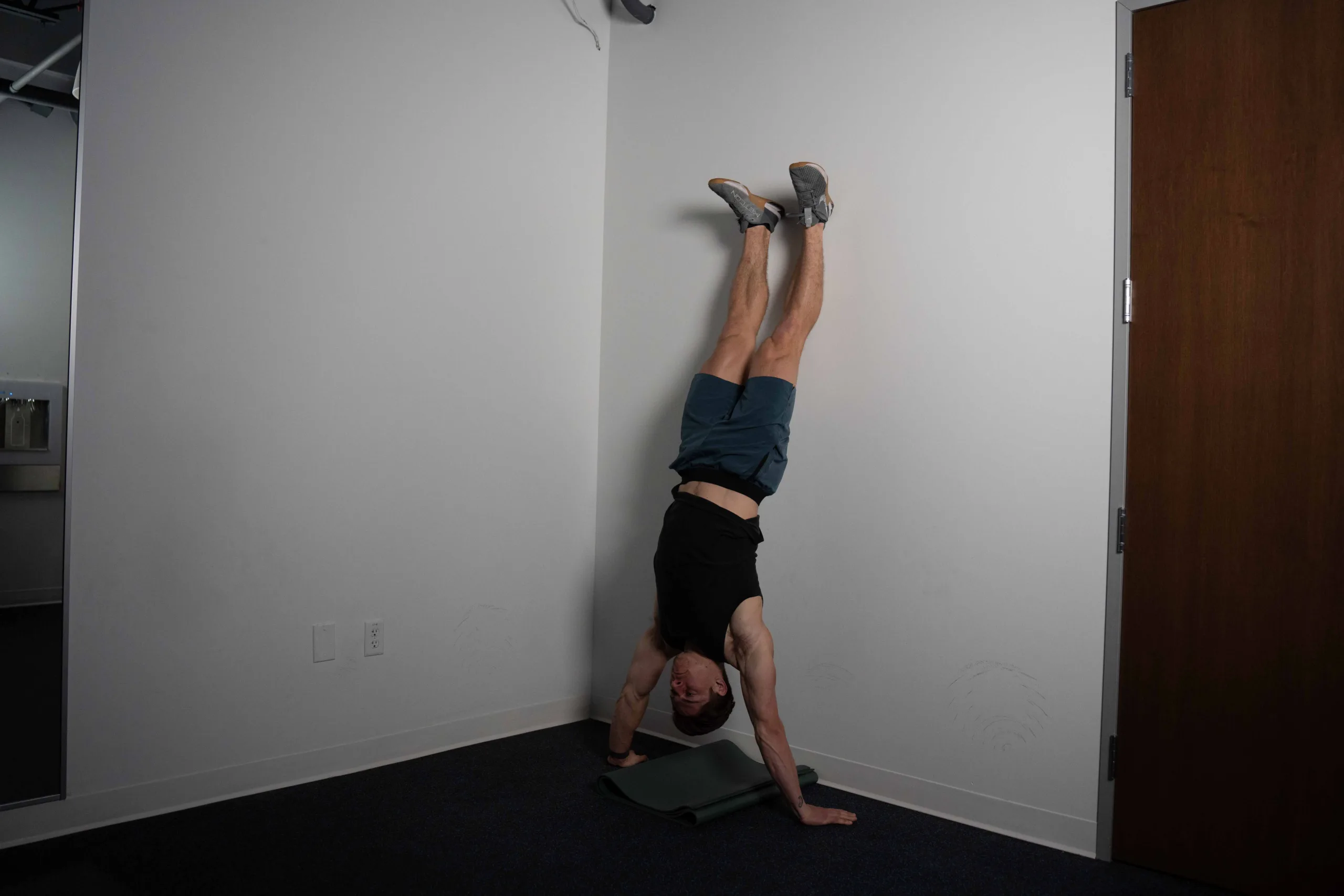How to Master Kipping Handstand Push Ups

Handstands are a gymnastic staple, but unless you took to gymnastics as a kid, they’re not easy to learn. Holding a freestanding handstand for just one minute can take years to perfect, but even the less gymnastically-inclined athlete can learn to do handstand push ups against a wall. (That means you.)

A guide to getting upside down like a pro
The CrossFit Games popularized handstand push ups as a movement accessible to most people with arms and not nearly as intimidating or time-consuming as a freestanding handstand. Watching professional athletes blow up their shoulders by doing huge sets of inverted push ups is super fun and inspiring. Have you ever noticed how jacked their shoulders are?
Isn’t it time you made it to that point? (Well, maybe not the Games, but definitely the HSPU mastery.)We wrote this guide to get you working on the necessary basics and progressions for handstand push ups. Nailing that upside-down strength carries over into a ton of other movements too, so let’s get crackin’.
Kipping vs strict
The age-old battle of “to kip or not to kip” is so outdated—as with pretty much all gymnastics movements, a pro gymnast can do both. Many coaches encourage building up your strength and coordination prerequisites by practicing the strict movement first.
For some beginners or novice athletes, there comes a point when it’s easier to pick up the kipping rhythm even if they can’t yet rep out a ton of strict HSPU (just like with strict vs. kipping pull ups).
The value of kipping comes in speed and high-volume output. CrossFit athletes use kipping handstand push ups in fast, intense workouts designed to get your heart racing. Like with pull ups, kipping is programmed more often in metabolic conditioning training (metcons), while the strict version is usually used to build strength and skill. It’s worthwhile to learn both.
How to Do a Kipping Handstand Push up
Kipping handstand push up points of performance
Setup
Find a wall free of distracting objects and with plenty of space. Be wary of any squat racks, nearby equipment, or gym friends who might catch a foot to the face. Place an ab mat or a gymnastic mat against the wall to cushion your head.
Kick up into a solid handstand with your heels against the wall and your hands framing the ab mat. Engage your lats, keep your core tight, spine neutral (don’t let your low back sag), and drive your heels up the wall. You should feel like you’re “reaching” toward the floor or actively pushing the floor away from you. Look out and ahead, not down at the floor, to keep your neck neutral.
Lower
With control, bend your elbows and lower the crown of your head to the mat. Don’t lose tension and crash down or you’ll suffer the consequence of your bodyweight + your neck + gravity. The three points of your head and hands will create a tripod position (like three legs of a camera tripod). Your head is just for stabilization, not to completely support your weight.
Tuck
Holding your tripod position steady, sit your butt back toward the wall and hinge at the waist, pulling your knees down toward your triceps. This is the tucked position where your kip starts. It kind of looks like a waiter in an upside down squat holding a tray over his head.
Explode & Press
The actual push up happens in a series of quick, fluid movements. From your tucked position, launch your feet back up the wall, driving your heels toward the ceiling. The second your hips reach full extension and your body hits a point of weightlessness (Sound familiar? Like all Olympic weightlifting.), use the momentum to press into the floor and extend your arms overhead. You’ll land back in your original handstand position.
The goal is to harness the power from your explosive hip extension to take some of the work away from your core, arms and shoulders. In a strict handstand push up, you don’t get any help from your legs. Try maximizing your hip power by pulling your pelvis in toward your belly at the bottom of your tuck instead of leaving your hips on the wall.
HSPU Scaling, Progressions & Variations
Check out this video for some handstand push up variations and pay attention to their similarities and differences. The pike push up on a box is a great place to start getting the hang of the strict movement while deficit HSPU are more advanced and strength-focused. The freestanding strict handstand push up is Level 10 difficulty, wow.
yoga headstands
Getting confident in every version of a freestanding headstand is a lesser-known secret to handstand push up mastery. When supporting yourself upside down is easy, you don’t have to work as hard to balance. Plus, being comfortable upside down comes with some nice health benefits—it improves your motor control, spatial awareness, and circulation.
Shoulder mobility
Love it or hate it, having mobile shoulders helps with every overhead movement including handstand push ups. If your shoulders, chest, and lats are stiff, sticky and restricted, it’ll be that much harder to support yourself in proper alignment against the wall. Do some regular soft tissue work and long-hold stretches to open up your overhead positioning.
barbell push press
The push press is the one right-side up movement that most closely mimics the handstand push up. Your arms and head make a similarly tripod shape while your core and shoulders are doing most of the work. There’s no excessive tuck, but you still bend your knees and use your legs to drive the barbell up before pressing.
hollow body holds and rocks
A running theme in any gymnastics practice is this: you probably need to get better at the hollow body position. For everything from handstand walks to pullups and bar muscle ups, the hollow body is essential. Handstand push ups are no exception. A strong, stable core keeps your back from arching and holds your body nice and tight when you’re upside down. Nobody likes a banana back.
Wall walks
A surprisingly long and taxing movement, wall walks are perfect for hammering away at some pressing strength and core/shoulder stability. Keep your abs tight and see if you can get your nose as close to the wall as possible. Try not to flop down off the wall.
Bonus: Try HSPU Negatives
Kick up to the wall and lower down with a 3-5 second tempo. Pull your knees down to your tuck position so you can come off the wall, then kick up and work the negative again. Just like with pull up negatives, this drills the point of greatest tension for the movement and translates to stronger strict handstand push ups.

Lily frei
Lily is TrainHeroic’s Marketing Content Creator and a CF-L1 with an English background. She was a successful freelance marketer for the functional fitness industry until being scooped up by TrainHeroic. An uncommon combo of bookish, artsy word-nerd and lifelong athlete, Lily is passionately devoted to weightlifting, CrossFit, yoga, dance, and aerial acrobatics. Find her showcasing her artist-athlete hobbies on IG @lilylectric.

Join the community
Sign up for the latest training news and updates from TrainHeroic
Support
Made with love, sweat, protein isolate and hard work in Denver, CO
© 2023 TrainHeroic, Inc. All rights reserved.




